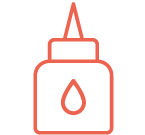Vinyl acetate ethylene copolymer dispersions are synthesized via emulsion polymerization from the monomers vinyl acetate and ethylene. These polymers are formed in the presence of water, and the product is a milk-like latex emulsion. Vinyl acetate is a hard monomer that, when polymerized, forms poly (vinyl acetate) and is widely used in adhesive applications. The incorporation of ethylene as a comonomer effectively lowers the glass transition temperature of the final VAE copolymer without the incorporation of plasticizers which can migrate. The ethylene comonomer reduces water sensitivity (hydrophobicity) and enhances flexibility, toughness, adhesion, and durability. VAE dispersions provide environmental advantages since they exhibit good film-forming properties without coalescing agents, for example, in low VOC paint and coatings.
VAE dispersions can be spray-dried into powders. These VAE polymer powders are redispersible in water and the properties are unchanged.
 Construction
Construction
 Nonwovens
Nonwovens
 Adhesives
Adhesives
 Textiles
Textiles
 Printing & Packaging
Printing & Packaging
 Paper
Paper
 Paints & Coatings
Paints & Coatings
